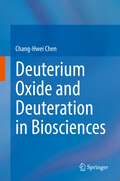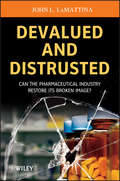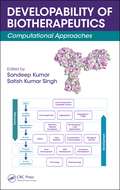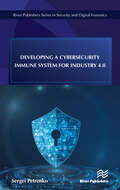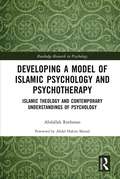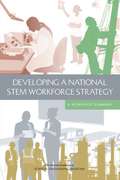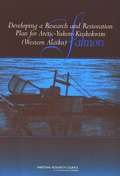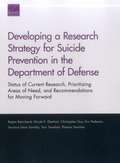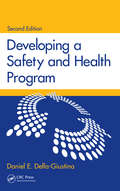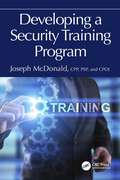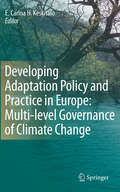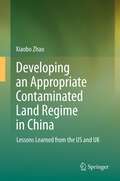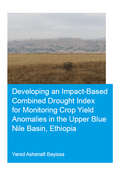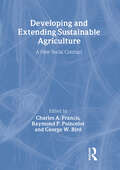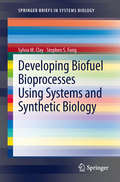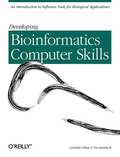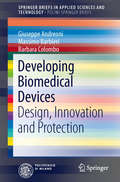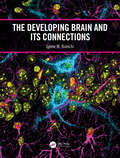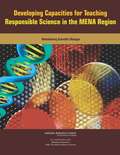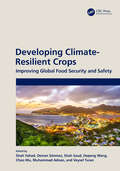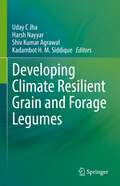- Table View
- List View
Deuterium Oxide and Deuteration in Biosciences
by Chang-Hwei ChenThis new book provides comprehensive coverage of the subjects of deuterium oxide and deuteration in biosciences, with an emphasis on the biochemical, biomedical, and pharmacological aspects. Deuterium oxide and deuteration effects also offer various implications for health-related issues, including diseases, vaccines and drugs. Organized in six sections, the chapter topics include the role of regular and heavy water in biosciences, and their implications to biomolecules, biochemical processes, health-related research, and pharmacology. Due to the broad scope, the book may be used as a supplemental text for upper-level undergraduate and graduate courses in the related fields of biochemistry, biology, biomedical sciences, biophysics, and pharmacology. Researchers and pharmaceutical industry professionals will also find the content useful in order to gain knowledge and better understand the implications of deuterium oxide and deuteration research.
Deutsch-jüdische Begegnungen mit dem Buddhismus: Zwischen Moses und Buddha, 1890-1940
by Sebastian MuschIn Deutschland verwandelte sich der Buddhismus um die Jahrhundertwende von einem obskuren Thema, das nur für einige wenige Gelehrte von Interesse war, in ein kulturelles Phänomen. Viele der bedeutendsten Autoren dieser Zeit wurden von diesem rasanten Aufstieg des Buddhismus tiefgreifend beeinflusst - unter ihnen einige der bekanntesten Namen des deutsch-jüdischen Kanons. Sebastian Musch gräbt diese vernachlässigte Dimension deutsch-jüdischer Identität aus und zeichnet anhand von philosophischen Abhandlungen, Romanen, Essays, Tagebüchern und Briefen die Geschichte der jüdisch-buddhistischen Begegnungen bis zum Beginn des Zweiten Weltkriegs nach. Franz Rosenzweig, Martin Buber, Leo Baeck, Theodor Lessing, Jakob Wassermann, Walter Hasenclever und Lion Feuchtwanger werden neben anderen, weniger bekannten Persönlichkeiten wie Paul Cohen-Portheim und Walter Tausk vorgestellt. Wie Musch zeigt, verhandelten diese Denker, als sie über den Buddhismus schrieben, auch ihr eigenes Jüdischsein.
Deutschland und der Treibhauseffekt: Gesellschaftsphänomene und Perspektiven einer Energietransformation
by Kay GolzeHier wird ein Ansatz zur Beschreibung des gesellschaftlichen Phänomens Klimawandel präsentiert. Die Suche nach den Ursachen und Auswirkungen dieses epochalen und globalen Naturereignisses erfolgt außerhalb der Klimawissenschaften, aber unter deren Berücksichtigung. Die Analysen geben einen unerwartet umfassenden Blick in die innere Mechanik des Phänomens und öffnen neue Fenster zur Betrachtung. Auf dieser Basis wird das einmalige deutsche Gesellschaftsexperiment der Energietransformation durchleuchtet.
Deutschlands Energiezukunft: Kann die Energiewende gelingen?
by Manfred PoppDeutschlands Energiezukunft Kann die Energiewende gelingen? Deutschlands Energiezukunft – wie wird sie aussehen? Mit der Energiewende hat sich Deutschland das neue und ehrgeizige Ziel gesetzt, bis zum Jahr 2050 eine klimaneutrale Energieversorgung zu verwirklichen. Kann das gelingen? Dieses Buch widmet sich der Entwicklung und den Möglichkeiten zur Deckung des Energiebedarfs der Welt sowie den Alternativen, die Deutschland zur Verfügung stehen. Der Autor verzichtet auf eine Polarisierung des Themas und gibt keine fertige Antwort auf die Frage nach Deutschlands Energiezukunft. Er will vielmehr den Leser in die Lage versetzen, sich ein eigenes Urteil bilden zu können über die Größe der Herausforderung, die Probleme, mit denen wir konfrontiert sind, und die Lösungswege, die uns offenstehen. Ergänzendes Material unter www.wiley-vch.de.
Devalued and Distrusted
by John L. LamattinaAn expert's view on solving the challenges confronting today's pharmaceutical industryAuthor John LaMattina, a thirty-year veteran of the pharmaceutical industry and former president of Pfizer's Global R&D Division, is internationally recognized as an expert on the pharmaceutical industry. His first book, Drug Truths: Dispelling the Myths About Pharma R&D, was critically acclaimed for clearing up misconceptions about the pharmaceutical industry and providing an honest account of the contributions of pharmaceutical research and development to human health and well-being.As he toured the country discussing Drug Truths, Dr. LaMattina regularly came across people who were filled with anger, accusing the pharmaceutical industry of making up diseases, hiding dangerous side effects, and more. This book was written in response to that experience, critically examining public perceptions and industry realities.Starting with "4 Secrets that Drug Companies Don't Want You to Know," Devalued and Distrusted provides a fact-based account of how the pharmaceutical industry works and the challenges it faces. It addresses such critical issues as:Why pharmaceutical R&D productivity has declinedWhere pharmaceutical companies need to invest their resourcesWhat can be done to solve core health challenges, including cancer, diabetes, and neurodegenerative diseasesHow the pharmaceutical industry can regain public trust and resuscitate its imageOur understanding of human health and disease grows daily; however, converting science into medicine is increasingly challenging. Reading Devalued and Distrusted, you'll not only gain a greater appreciation of those challenges, but also the role that the pharmaceutical industry currently plays and can play in solving those challenges.Get to know the author: Read an interview with John LaMattina or watch a video on ChemistryViews! Interview: John LaMattina: 30 Years in PharmaVideo: Can the Pharmaceutical Industry Restory its Broken Image?
Developability of Biotherapeutics: Computational Approaches
by Sandeep Kumar Satish Kumar SinghBiopharmaceuticals are emerging as frontline medicines to combat several life-threatening and chronic diseases. However, such medicines are expensive to develop and produce on a commercial scale, contributing to rising healthcare costs. Developability of Biotherapeutics: Computational Approaches describes applications of computational and molecular
Developing a Cybersecurity Immune System for Industry 4.0
by Sergei PetrenkoCyber immune systems try to mimic the adaptive immune system of humans and animals because of its capability to detect and fend off new, unseen pathogens. Today's current cyber security systems provide an effective defense mechanism against known cyber-attacks but are not so good when it comes to defending against unknown attacks. This book describes the possible development and organization of self-healing computing based on cyber immunity techniques and aimed at working in the new realm of Industry 4.0. Industry 4.0 is the trend towards automation and data exchange in manufacturing technologies and processes which include cyber-physical systems (CPS), the internet of things (IoT), industrial internet of things (IIOT), cloud computing, cognitive computing and artificial intelligence. The book describes the author’s research and development of cyber-immunity systems that will prevent the destruction of critical information infrastructure by future unknown cyber-attacks and thus avoid the significant or catastrophic consequences of such attacks.The book is designed for undergraduate and post-graduate students, for engineers in related fields as well as managers of corporate and state structures, chief information officers (CIO), chief information security officers (CISO), architects, and research engineers in the field of cybersecurity.This book contains four chapters1. Cyber Immunity Concept of the Industry 4.0; 2. Mathematical Framework for Immune Protection of Industry 4.0; 3. Trends and prospects of the development of Immune Protection of Industry 4.0; 4. From detecting cyber-attacks to self-healing Industry 4.0;
Developing a Model of Islamic Psychology and Psychotherapy: Islamic Theology and Contemporary Understandings of Psychology (Routledge Research in Psychology)
by Abdallah RothmanAt a time when there is increasing need to offer psychotherapeutic approaches that accommodate clients’ religious and spiritual beliefs, and acknowledge the potential for healing and growth offered by religious frameworks, this book explores psychology from an Islamic paradigm and demonstrates how Islamic understandings of human nature, the self, and the soul can inform an Islamic psychotherapy. Drawing on a qualitative, grounded theory analysis of interviews with Islamic scholars and clinicians, this unique volume distils complex religious concepts to reconcile Islamic theology with contemporary notions of psychology. Chapters offer nuanced explanations of relevant Islamic tradition and theological sources, consider how this relates to Western notions of psychotherapy and common misconceptions, and draw uniquely on first-hand data to develop a new theory of Islamic psychology. This, in turn, informs an innovative and empirically driven model of practice that translates Islamic understandings of human psychology into a clinical framework for Islamic psychotherapy. An outstanding scholarly contribution to the modern and emerging discipline of Islamic psychology, this book makes a pioneering contribution to the integration of the Islamic sciences and clinical mental health practice. It will be a key resource for scholars, researchers, and practicing clinicians with an interest in Islamic psychology and Muslim mental health, as well as religion, spirituality and psychology more broadly.
Developing a National STEM Workforce Strategy: A Workshop Summary
by National Academies of Sciences Engineering Medicine Policy Global Affairs Board on Higher Education Workforce Planning Committee for the National Summit on Developing a STEM Workforce Strategy Joe AlperThe future competitiveness of the United States in an increasingly interconnected global economy depends on the nation fostering a workforce with strong capabilities and skills in science, technology, engineering, and mathematics (STEM). STEM knowledge and skills enable both individual opportunity and national competitiveness, and the nation needs to develop ways of ensuring access to high-quality education and training experiences for all students at all levels and for all workers at all career stages. The National Science Foundation (NSF) holds a primary responsibility for overseeing the federal government’s efforts to foster the creation of a STEM-capable workforce. As part of its efforts in this endeavor, NSF’s Directorate on Education and Human Resources asked the National Academies of Sciences, Engineering, and Medicine to convene a workshop that would contribute to NSF’s preparation of a theoretical and evidence-based STEM Workforce Development R&D Core Framework. Participants discussed research themes, identified gaps and emerging research opportunities, and recommended refinements in the goals of the framework. This report summarizes the presentations and discussions from the workshop.
Developing a Research and Restoration Plan for Arctic-Yukon-Kuskokwim (Western Alaska) Salmon
by Committee on Review of Arctic-Yukon-Kuskokwim (Western Alaska) Research Restoration Plan for SalmonRecent declines in the abundance of salmon in the Arctic-Yukon-Kuskokwim (AYK) region of western Alaska have created hardships for the people and communities who depend on this resource. In 2002, the AYK Sustainable Salmon Initiative (SSI) was created to undertake research to understand the reasons for this decline and to help support sustainable management in the region. This book makes recommendations for developing the research that the AYK SSI science plan should be based on, and relates the development of a restoration plan to the results of that research.
Developing a Research Strategy for Suicide Prevention in the Department of Defense: Status of Current Research, Prioritizing Areas of Need, and Recommendations for Moving Forward
by Rajeev Ramchand Nicole K. Eberhart Christopher Guo Eric Pedersen Terrance Dean Savitsky Terri Tanielian Phoenix VoorhiesTo support U. S. Department of Defense (DoD) efforts to create a unified, comprehensive strategic plan for suicide prevention research, a RAND study cataloged studies funded by DoD and other entities, examined whether current research maps to DoD's strategic research needs, and provided recommendations to encourage better alignment and narrow the research-practice gap when it comes to disseminating findings to programs serving military personnel.
Developing a Safety and Health Program
by Daniel E. Della-GiustinaReflecting changes in the field during the ten years since the publication of the first edition, Developing a Safety and Health Program, Second Edition examines the elements of a safety and health program and delineates how to incorporate them into an organization's safety efforts. It begins by defining safety policy and providing an overview of OS
Developing a Security Training Program
by Joseph McDonaldDeveloping a Security Training Program focuses on how to establish a comprehensive training program for a security department from the ground up. This book highlights formal curriculum development, consistent and continual training, and the organizational benefits including how such security training will be a value-add.It’s long overdue for the industry to revisit old security training models from the past — to both general staff as well as to the dedicated security staff and professionals within organizations — and examine and revamp such with a fresh perspective. Given the current, dynamic environment for businesses — and the threats businesses face — it is important that any such training consider all procedures and policies, and be fully integrated into the company culture. This includes maintaining an eye on budgetary and financial costs while recognizing the need to budget for more training resources to maintain resilience and adaptability to current challenges and future changes to the environment. There is only one way to prepare your staff and that is through comprehensive and consistent training.Developing a Security Training Program provides the blueprint and tools for professionals to provide ongoing, targeted, and comprehensive security training at a low, budget-friendly cost.
Developing Adaptation Policy and Practice in Europe: Multi-level Governance of Climate Change
by E. Carina KeskitaloMitigation will not be sufficient for us to avoid climate change and we will need to adapt to its consequences. This book targets the development of adaptation policy in European countries with different relations between central and regional/local government.
Developing an Appropriate Contaminated Land Regime in China
by Xiaobo ZhaoLike all industrialized countries, China has encountered increasing problems with land contamination in recent years. Abandoned mining and manufacturing sites and obsolete industrial complexes, while also creating new polluting industrial enterprises, represent impending environmental threats. More importantly, a number of social and economic problems have developed and must be dealt with, in some cases urgently. Contaminated land laws and regulations have been established and have evolved in the US and UK and many other jurisdictions over the past few decades. These regimes have substantially influenced the relevant legislation in the context of numerous Asian and European countries and will inevitably benefit similar legislative efforts in China. This book is the first monograph that focuses on how China can learn from the US and UK with respect to contaminated land legislation and comprehensively illustrates how contaminated land law could be created in China. It will be of interest to academics and practitioners in environmental law in China, as well as the US and UK.
Developing an Impact-Based Combined Drought Index for Monitoring Crop Yield Anomalies in the Upper Blue Nile Basin, Ethiopia (IHE Delft PhD Thesis Series)
by Yared A. BayissaHaving a robust drought monitoring system for Ethiopia is crucial to mitigate the adverse impacts of droughts. Yet, such monitoring system still lacks in Ethiopia, and in the Upper Blue Nile (UBN) basin in particular. Several drought indices exist to monitor drought, however, these indices are unable, individually, to provide concise information on the occurrence of meteorological, agricultural and hydrological droughts. A combined drought index (CDI) using several meteorological, agricultural and hydrological drought indices can indicate the occurrence of all drought types, and can provide information that facilitates the drought management decision-making process. This thesis proposes an impact-based combined drought index (CDI) and a regression prediction model of crop yield anomalies for the UBN basin. The impact-based CDI is defined as a drought index that optimally combines the information embedded in other drought indices for monitoring a certain impact of drought, i.e. crop yield for the UBN. The developed CDI and the regression model have shown to be effective in indicating historic drought events in UBN basin. The impact-based CDI could potentially be used in the future development of drought monitoring in the UBN basin and support decision making in order to mitigate adverse drought impacts.
Developing and Extending Sustainable Agriculture: A New Social Contract
by Charles A. Francis Raymond P. Poincelot George W. BirdGet the latest sustainable agriculture practices and keep an eye on the future Developing and Extending Sustainable Agriculture: A New Social Contract explores the challenges faced by today’s farmers and ranchers to provide practical strategies to develop a twenty-first century system of sustainable agriculture that is economically sound, environmentally compatible, and socially acceptable. This comprehensive look at the current state of farming and ranching presents leading authorities discussing concepts and approaches in sustainable agriculture such as crop rotations, integrated pest management, alternative sources of nutrients to maintain productivity, and rotational grazing systems.Presently there is a trend toward a more industrial agriculture and a global food system that will bring long-term negative impacts. If farmers look thoughtfully toward the future, alternatives are now available to help solve these problems to provide agricultural sustainability for generations to come. Developing and Extending Sustainable Agriculture: A New Social Contract provides a model for integrated research and outreach to everyone interested in sustainable development. A sensible framework of practical short-term strategies are combined with visionary long-term plans to provide viable approaches to sustain agriculture, secure our food system, and develop a more equitable society for the future. The text includes several tables and figures, extensive references, and comprehensive bibliographies.Topics in Developing and Extending Sustainable Agriculture: A New Social Contract include: the evolution of the concept of equitable and sustainable development on-farm research farmer to farmer education IPM (integrated pest management) soil management managed grazing whole-farm planning, including economic analysis training for sustainable agriculture motivation theory and research to foster positive sustainable development organic farming productivity the future of sustainable agriculture much, much more Developing and Extending Sustainable Agriculture: A New Social Contract is enlightening, horizon-expanding reading perfect for educators, students, government decision makers, cooperative extension educators, specialists, administrators, citizen members of county extension boards, and administrators in land grant universities.
Developing Biofuel Bioprocesses Using Systems and Synthetic Biology
by Sylvia M. Clay Stephen S. FongAdvances in technological and analytical methods have fostered rapid growth of systems biology and synthetic biology. There continues to be rapid changes and discoveries in both fields with a small number of recent peer-reviewed reviews indicating some of the relationships between systems biology and synthetic biology. This proposed SpringerBrief will cover core concepts of systems biology and synthetic biology and illustrate the implementation of associated research methodologies for an integrated approach to specifically address engineering microorganisms for biofuel production.
Developing Bioinformatics Computer Skills
by Cynthia Gibas Per JambeckBioinformatics--the application of computational and analytical methods to biological problems--is a rapidly evolving scientific discipline. Genome sequencing projects are producing vast amounts of biological data for many different organisms, and, increasingly, storing these data in public databases. Such biological databases are growing exponentially, along with the biological literature. It's impossible for even the most zealous researcher to stay on top of necessary information in the field without the aid of computer-based tools. Bioinformatics is all about building these tools. Developing Bioinformatics Computer Skills is for scientists and students who are learning computational approaches to biology for the first time, as well as for experienced biology researchers who are just starting to use computers to handle their data. The book covers the Unix file system, building tools and databases for bioinformatics, computational approaches to biological problems, an introduction to Perl for bioinformatics, data mining, and data visualization. Written in a clear, engaging style, Developing Bioinformatics Computer Skills will help biologists develop a structured approach to biological data as well as the tools they'll need to analyze the data.
Developing Bioinformatics Computer Skills
by Per Jambeck Cynthia GibasIntroduces the field of bioinformatics: "the application of computational and analytical methods to biological problems.
Developing Biomedical Devices
by Giuseppe Andreoni Massimo Barbieri Barbara ColomboDuring the past two decades incredible progress has been achieved in the instruments and devices used in the biomedical field. This progress stems from continuous scientific research that has taken advantage of many findings and advances in technology made available by universities and industry. Innovation is the key word and in this context legal protection and intellectual property rights (IPR) are of crucial importance. This book provides students and practitioners with the fundamentals for designing biomedical devices and explains basic design principles. Furthermore, as an aid to the development of devices and products for healthcare, it presents a brief description of the human body, covering anatomy and physiology, that will assist the reader in understanding the origin of biosignals, their significance and the technology to be used in their measurement. Issues concerning IPR and protections are also fully discussed, with examples and opportunities for IPR exploitation.
The Developing Brain and its Connections
by Lynne M. BianchiThe Developing Brain and Its Connections describes the processes of neural development from neural induction through synaptic refinement. Each chapter explores specific mechanisms of development and describes key experiments from invertebrate and vertebrate animal models. By highlighting experimental methods and explaining how hypotheses evolve over time, readers learn essential facts while strengthening their appreciation of the scientific method. Discussions of neurodevelopmental disorders and therapeutic approaches to them bridge basic science discoveries with the clinical aspects of the field. Descriptions of recent work by student researchers and medical residents demonstrate career pathways and options for those interested in pursuing any area neural development. With this distinctive approach, easy-to-follow writing style, and clear illustrations, The Developing Brain presents an accessible approach to neural development for undergraduate students. Related TitlesLuo, L. Principles of Neurobiology, 2nd edition (ISBN 9780815346050)Simon, S. A., series ed. Frontiers in Neuroscience https://www.routledge.com/Frontiers-in-Neuroscience/book-series/CRCFRONEUSCI Feltz, A., ed. Physiology of Neurons (ISBN 978-0-8153-4600-5)
Developing Capacities for Teaching Responsible Science in the MENA Region
by Committee on Developing a Framework for an International Faculty Development Project on Education About Research in the Life Sciences with Dual Use Potential National Research Council Board on Life Science Division on Earth and Life Studies The World Academy of SciencesSpurred on by new discoveries and rapid technological advances, the capacity for life science research is expanding across the globe--and with it comes concerns about the unintended impacts of research on the physical and biological environment, human well-being, or the deliberate misuse of knowledge, tools, and techniques to cause harm. This report describes efforts to address dual use issues by developing institutes around the world that will help life sciences faculty learn to teach about the responsible conduct of science. Based on the successful National Academies Summer Institute for Undergraduate Biology Education and on previous NRC reports on effective methods for teaching about dual use issues, the report's authoring committee designed a general framework for the faculty institutes and chose the Middle East-North Africa (MENA) region to test a prototype faculty institute. In September 2012, the first Institute was held in Aqaba, Jordan, bringing together 28 participants from Algeria, Egypt, Jordan, Libya, and Yemen to engage with effective, evidence-based teaching methods, develop curricular materials for use in their own classrooms, and become community leaders on dual use and related topics. Developing Capacities for Teaching Responsible Science in the MENA Region: Refashioning Scientific Dialogue offers insights from the institute that will help in the design and implementation of future programs in the MENA region, and in other parts of the world.
Developing Climate-Resilient Crops: Improving Global Food Security and Safety (Footprints of Climate Variability on Plant Diversity)
by Shah FahadDeveloping Climate-Resilient Crops: Improving Global Food Security and Safety is timely, as the world is gradually waking up to the fact that a global food crisis of enormous proportions is brewing. Climate change is creating immense problems for agricultural productivity worldwide, resulting in higher food prices. This book elucidates the causative aspects of climate modification related to agriculture, soil, and plants, and discusses the relevant resulting mitigation process and also how new tools and resources can be used to develop climate-resilient crops. Features: Addresses the limits of the anthropogenic global warming theory advocated by the Intergovernmental Panel on Climate Change Presents the main characters (drought tolerance, heat tolerance, water-use efficiency, disease resistance, nitrogen-use efficiency, nitrogen fixation, and carbon sequestration) necessary for climate-resilient agriculture Delivers both theoretical and practical aspects, and serves as baseline information for future research Provides valuable resource for those students engaged in the field of environmental sciences, soil sciences, agricultural microbiology, plant pathology, and agronomy Highlights factors that are threatening future food production
Developing Climate Resilient Grain and Forage Legumes
by Uday C Jha Harsh Nayyar Shiv Kumar Agrawal Kadambot H. M. SiddiqueThis edited book covers all aspects of grain legumes including negative impact of abiotic and biotic stresses under the changing global climate. It discusses the role of various subject disciplines ranging from plant breeding, genetics, plant physiology, molecular biology, and genomics to high-throughput phenotyping and other emerging technologies for sustaining global grain and fodder legume production to alleviate impending global food crises. The book offers strategies to ensure plant-based dietary protein security across the globe. It covers all major commercial legume crops used as food, feed and fodder. This book is targeted to graduate and postgraduate students, researchers, progressive farmers and policymakers to inform them of the importance of cultivating grain and fodder legumes for future global food and nutritional security and for maintaining sustainable ecosystem.
